Are you wondering why your dog licks your cat? The behavior of your dog licking your cat can be puzzling, but at solcat.net, we’re here to shed light on this common interspecies interaction, and it’s often a sign of affection, grooming behavior, or simply a way to explore the world through taste. This action may be a sign of interspecies affection, a request for attention, or even a form of canine grooming. Keep reading to discover the various reasons and implications of this behavior and how it affects your furry companions. We’ll cover everything from dog-cat dynamics to understanding pet interactions and promoting harmonious cohabitation.
1. Affection and Social Bonding: Is My Dog Showing Love to My Cat?
Yes, your dog licking your cat is often a display of affection and a way of reinforcing their social bond. Dogs use licking as a way to show love and strengthen relationships within their pack.
When dogs lick cats, it’s often a sign of affection, mirroring how they interact with their human families. This behavior can be seen as a way to bond and establish a stronger relationship between the two animals.
- Pack Mentality: Dogs, as social animals, have a natural instinct to form packs. In a multi-pet household, cats can be integrated into this pack structure. Licking serves as a social cue, similar to how dogs groom each other to maintain social cohesion.
- Affectionate Gesture: Licking can be an expression of love and care. Dogs often lick their owners to show affection, and they may extend the same behavior to their feline housemates. This gesture helps in solidifying the bond between them.
- Creating a Sense of Security: A dog licking a cat can also create a sense of security and comfort for both animals. The repetitive motion and gentle touch can be soothing, especially for cats that are used to being groomed by their mothers.
- Mimicking Maternal Behavior: Dogs may sometimes lick cats as a way of mimicking maternal grooming behaviors. This is more common in female dogs, particularly those who have had puppies.
- Seeking Attention: Sometimes, a dog may lick a cat simply to get their attention. If the cat responds positively, the dog learns that licking is an effective way to initiate interaction.
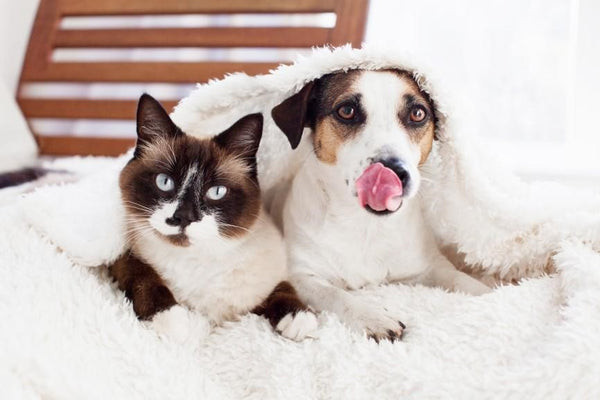 Dog affectionately licking a cat's head, showcasing their bond
Dog affectionately licking a cat's head, showcasing their bond
2. Grooming Behavior: Is My Dog Trying to Clean My Cat?
Yes, your dog could be trying to groom your cat. Grooming is a common behavior among social animals, and dogs sometimes extend this to their feline companions.
Grooming is an essential part of social behavior for many animals, including dogs. When a dog licks a cat, it might be an attempt to help keep the cat clean, especially in hard-to-reach areas.
- Social Grooming: Grooming is a common social behavior in the animal kingdom. Dogs, being social animals, often engage in grooming activities with other members of their “pack,” including cats.
- Cleaning: Dogs may lick cats to help remove dirt, debris, or loose fur from their coat. This is especially common if the cat has difficulty grooming themselves or is elderly.
- Distribution of Oils: Licking can help distribute natural oils across the cat’s fur, which keeps the coat healthy and shiny. This is similar to how cats groom themselves.
- Mutual Grooming: While less common, some cats may reciprocate the grooming behavior by licking the dog in return. This mutual grooming further strengthens their bond and reinforces their social hierarchy.
- Behavioral Instinct: Grooming can also be a natural instinct for dogs, particularly breeds that were originally bred to work closely with other animals or humans.
3. Taste and Exploration: Does My Dog Like the Taste of My Cat’s Fur?
Yes, it’s possible your dog likes the taste of your cat’s fur. Dogs explore the world through their sense of smell and taste, and the unique scent and taste of a cat’s fur can be appealing to them.
Dogs often use their mouths to explore the world around them, and this includes their feline housemates. The taste and scent of a cat’s fur can be intriguing and enjoyable for some dogs.
- Sensory Exploration: Dogs have a highly developed sense of smell and taste. Licking allows them to gather information about their environment, including the unique scent of a cat.
- Salt and Oils: Cats produce natural oils and sweat that can be slightly salty, which some dogs find appealing. This can be a contributing factor to why dogs lick cats.
- Curiosity: Dogs are naturally curious and may lick cats simply to investigate their scent or taste. This is especially true for puppies and younger dogs.
- Texture: The texture of a cat’s fur can also be appealing to dogs. The soft, smooth fur can be satisfying to lick, providing a sensory experience that the dog enjoys.
- Individual Preferences: Just like humans, dogs have individual preferences. Some dogs may simply enjoy the taste or texture of a cat’s fur, while others may not be interested at all.
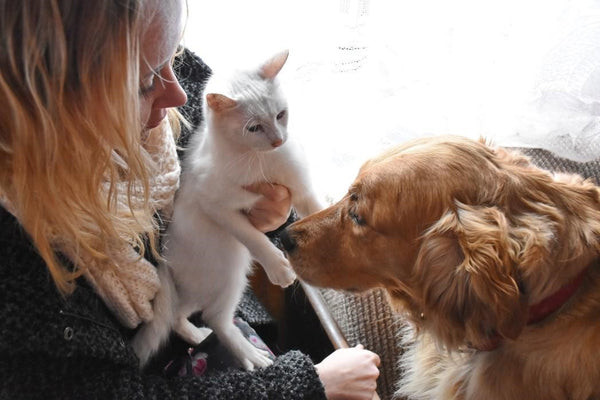 Golden retriever gently licking a tabby cat, illustrating a friendly interaction
Golden retriever gently licking a tabby cat, illustrating a friendly interaction
4. Attention-Seeking: Is My Dog Trying to Interact With My Cat?
Yes, your dog may be licking your cat to get their attention. Dogs are social creatures and often seek interaction with other members of their household, including cats.
Dogs are social animals that thrive on interaction. Licking can be a way for a dog to initiate contact with a cat, especially if the dog is bored or seeking attention.
- Social Interaction: Dogs crave social interaction and may use licking as a way to engage with their feline housemates. This is particularly true if the dog spends a lot of time alone.
- Play Invitation: Licking can be an invitation to play. Dogs may lick cats in an attempt to initiate a playful interaction, such as chasing or wrestling.
- Dominance: In some cases, licking can be a display of dominance. A dog may lick a cat to assert their position in the household hierarchy.
- Boredom: If a dog is bored or lacking stimulation, they may turn to licking as a way to entertain themselves. This is more common in dogs that are not getting enough exercise or mental enrichment.
- Learned Behavior: If a dog has learned that licking results in attention or positive interaction from the cat or their owner, they are more likely to repeat the behavior.
5. Anxiety and Compulsive Behavior: Is Licking a Sign of Stress?
Yes, in some cases, excessive licking can be a sign of anxiety or compulsive behavior. If your dog is constantly licking your cat, it may be a way to relieve stress or cope with underlying anxiety.
While licking is often a normal behavior, excessive or compulsive licking can be a sign of underlying anxiety or stress in dogs. This behavior can become problematic if it is disruptive or causes harm to the cat.
- Stress Relief: Licking releases endorphins, which have a calming effect on dogs. If a dog is feeling anxious or stressed, they may turn to licking as a way to self-soothe.
- Compulsive Behavior: In some cases, licking can become a compulsive behavior. This is more common in dogs with underlying anxiety disorders or those who have experienced trauma.
- Environmental Changes: Changes in the environment, such as moving to a new home or the addition of a new pet, can trigger anxiety and lead to compulsive licking behavior.
- Separation Anxiety: Dogs with separation anxiety may lick cats as a way to cope with their distress when their owners are away.
- Medical Issues: In rare cases, excessive licking can be a sign of an underlying medical issue, such as skin allergies or neurological problems.
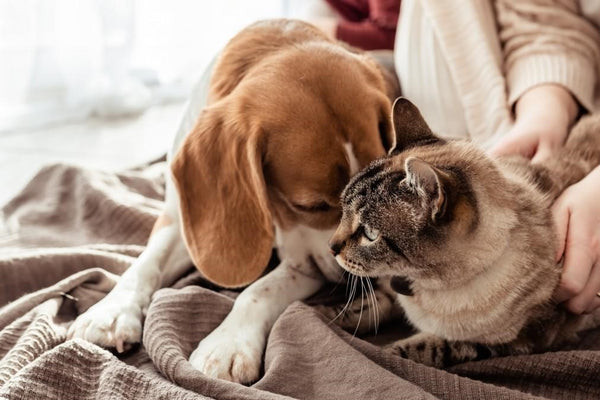 Beagle snuggling with a cat, representing comfort and companionship
Beagle snuggling with a cat, representing comfort and companionship
6. Potential Benefits of Dog Licking Cat
While it may seem odd, there are some potential benefits to a dog licking a cat, including improved coat health and stress reduction.
While excessive licking can be a concern, there are some potential benefits to this behavior, including improved coat health and stress reduction for both animals.
- Coat Health: Licking can help remove dirt and debris from the cat’s coat, keeping it clean and healthy. It can also distribute natural oils, which keep the fur shiny and moisturized.
- Stress Reduction: The act of licking releases endorphins, which can have a calming effect on both the dog and the cat. This can help reduce stress and anxiety in both animals.
- Bonding: Licking can strengthen the bond between the dog and the cat, reinforcing their social connection and creating a sense of security.
- Social Interaction: For dogs that crave social interaction, licking can provide a way to engage with their feline housemates and prevent boredom.
- Enhanced Well-being: When done in moderation and with the cat’s consent, licking can contribute to the overall well-being and happiness of both animals.
7. When to Be Concerned About Your Dog Licking Your Cat
Excessive or aggressive licking can be a sign of underlying issues. It’s important to monitor the behavior and intervene if the cat seems uncomfortable or distressed.
While licking is often a normal behavior, there are situations where it can become problematic and require intervention. It’s important to monitor the behavior and intervene if the cat seems uncomfortable or distressed.
- Cat’s Discomfort: If the cat is constantly trying to avoid the dog or shows signs of distress, such as hissing, swatting, or hiding, it’s important to intervene.
- Excessive Licking: If the dog is licking the cat excessively, to the point where the cat’s fur is constantly wet or irritated, it’s time to seek professional advice.
- Aggression: If the licking is accompanied by aggressive behavior, such as growling, snapping, or biting, it’s crucial to separate the animals and consult with a veterinarian or behaviorist.
- Skin Irritation: Excessive licking can lead to skin irritation and infections. If you notice redness, swelling, or hair loss on the cat’s skin, it’s important to seek veterinary care.
- Underlying Anxiety: If the licking is a sign of underlying anxiety or compulsive behavior, it’s important to address the root cause of the anxiety with the help of a veterinarian or behaviorist.
8. How to Discourage Excessive Licking
If the licking becomes problematic, there are several strategies you can use to discourage the behavior, including redirection and positive reinforcement.
If the licking becomes excessive or bothersome, there are several strategies you can use to discourage the behavior and promote a more harmonious relationship between your dog and cat.
- Redirection: When you see your dog licking the cat, redirect their attention to a different activity, such as playing with a toy or going for a walk.
- Positive Reinforcement: Reward your dog for good behavior, such as ignoring the cat or engaging in a different activity. This can help reinforce the desired behavior.
- Create Separate Spaces: Provide separate spaces for your dog and cat, where they can retreat to if they need a break from each other. This can help reduce stress and prevent unwanted interactions.
- Supervision: Supervise interactions between your dog and cat, especially when you are first introducing them or trying to modify their behavior.
- Consult a Professional: If you are struggling to manage the licking behavior on your own, consult with a veterinarian or certified behaviorist for guidance and support.
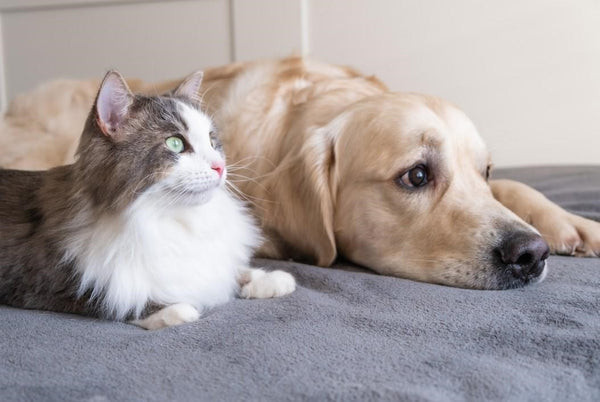 Cat and dog staring ahead, showcasing a peaceful coexistence
Cat and dog staring ahead, showcasing a peaceful coexistence
9. Medical Considerations: Is There a Health Issue Causing the Licking?
While less common, medical issues such as allergies or neurological problems can sometimes cause excessive licking. Consult with your veterinarian to rule out any underlying health concerns.
In rare cases, medical issues can contribute to excessive licking behavior in dogs. It’s important to rule out any underlying health concerns with the help of your veterinarian.
- Allergies: Skin allergies can cause itching and discomfort, leading dogs to lick excessively. If your dog has allergies, your veterinarian can recommend appropriate treatment options.
- Neurological Problems: In rare cases, neurological problems can cause compulsive licking behavior. Your veterinarian can perform diagnostic tests to rule out any neurological issues.
- Skin Infections: Skin infections can cause irritation and discomfort, leading dogs to lick excessively. Your veterinarian can prescribe antibiotics or other medications to treat the infection.
- Pain: If your dog is experiencing pain, they may lick excessively in an attempt to soothe the affected area. Your veterinarian can help identify and treat the source of the pain.
- Dental Problems: Dental problems, such as toothaches or gum disease, can cause dogs to lick excessively. Your veterinarian can perform a dental exam and recommend appropriate treatment.
10. Fostering a Harmonious Dog-Cat Relationship
Creating a peaceful environment for your dog and cat involves understanding their individual needs and promoting positive interactions. This includes providing separate spaces, supervised playtime, and consistent training.
Fostering a harmonious relationship between your dog and cat requires patience, understanding, and consistent effort. By creating a peaceful environment and promoting positive interactions, you can help your pets live together in harmony.
- Introduction: Introduce your dog and cat slowly and gradually, allowing them to get used to each other’s scent before allowing them to interact face-to-face.
- Separate Spaces: Provide separate spaces for your dog and cat, where they can retreat to if they need a break from each other. This can help reduce stress and prevent unwanted interactions.
- Supervised Playtime: Supervise playtime between your dog and cat, and intervene if either animal becomes too rough or aggressive.
- Training: Train your dog to obey commands, such as “leave it” or “stay,” which can be helpful in managing their behavior around the cat.
- Positive Reinforcement: Use positive reinforcement to reward your dog for good behavior around the cat, such as ignoring them or interacting calmly.
- Equal Attention: Make sure to give both your dog and cat equal attention and affection, to prevent jealousy and competition.
- Safe Environment: Create a safe and comfortable environment for both your dog and cat, with plenty of toys, beds, and hiding places.
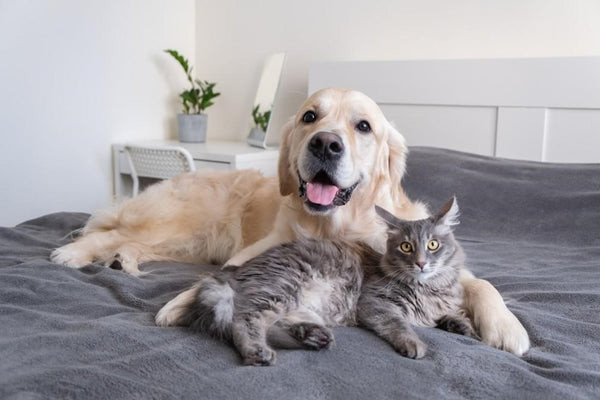 Labrador with a grey cat lying in front of him, symbolizing companionship
Labrador with a grey cat lying in front of him, symbolizing companionship
Understanding why your dog licks your cat involves considering various factors, from affection and grooming to attention-seeking and anxiety. By monitoring their behavior and addressing any underlying issues, you can ensure a harmonious relationship between your furry companions. For more insights into pet behavior and tips for fostering a peaceful multi-pet household, visit solcat.net. At solcat.net, you can find additional resources on cat behavior, dog training, and interspecies relationships. Learn about cat health, dog behavior modification, and creating a pet-friendly home.
Address: 950 Alaskan Way, Seattle, WA 98104, United States
Phone: +1 (206) 386-4000
Website: solcat.net
FAQ About Dogs Licking Cats
-
Why Does My Dog Lick My Cat’s face?
Your dog might lick your cat’s face as a sign of affection or to groom them. This behavior is often seen as a friendly gesture.
-
Is it normal for my dog to lick my cat excessively?
While some licking is normal, excessive licking may indicate boredom, anxiety, or a skin issue. Monitor the behavior and consult a vet if needed.
-
How can I stop my dog from licking my cat?
Use redirection techniques, such as offering a toy or a treat, and ensure both pets have separate, safe spaces.
-
Can dog saliva harm my cat?
Generally, dog saliva is not harmful to cats. However, if the cat has open wounds, it’s best to prevent licking to avoid potential infection.
-
Does licking help my dog and cat bond?
Yes, licking can help strengthen the bond between a dog and cat, as it’s a form of social interaction and grooming.
-
Why does my dog only lick my cat sometimes?
The behavior can vary based on the dog’s mood, the cat’s scent, and the environment. It might be more frequent during times of stress or boredom.
-
What should I do if my cat doesn’t like being licked?
Respect your cat’s boundaries. If your cat shows signs of discomfort, gently discourage the dog from licking and provide the cat with an escape route.
-
Could my dog be trying to assert dominance by licking my cat?
In some cases, licking can be a way for a dog to assert dominance. Observe other behaviors to determine if dominance is the underlying issue.
-
Is there a specific reason why my dog licks my cat’s ears?
Dogs might lick a cat’s ears to clean them or because they find the scent appealing. Monitor for any signs of irritation or discomfort.
-
How do I know if the licking is a sign of a bigger problem?
If the licking is obsessive, causes distress to either animal, or is accompanied by other unusual behaviors, consult with a vet or animal behaviorist.

